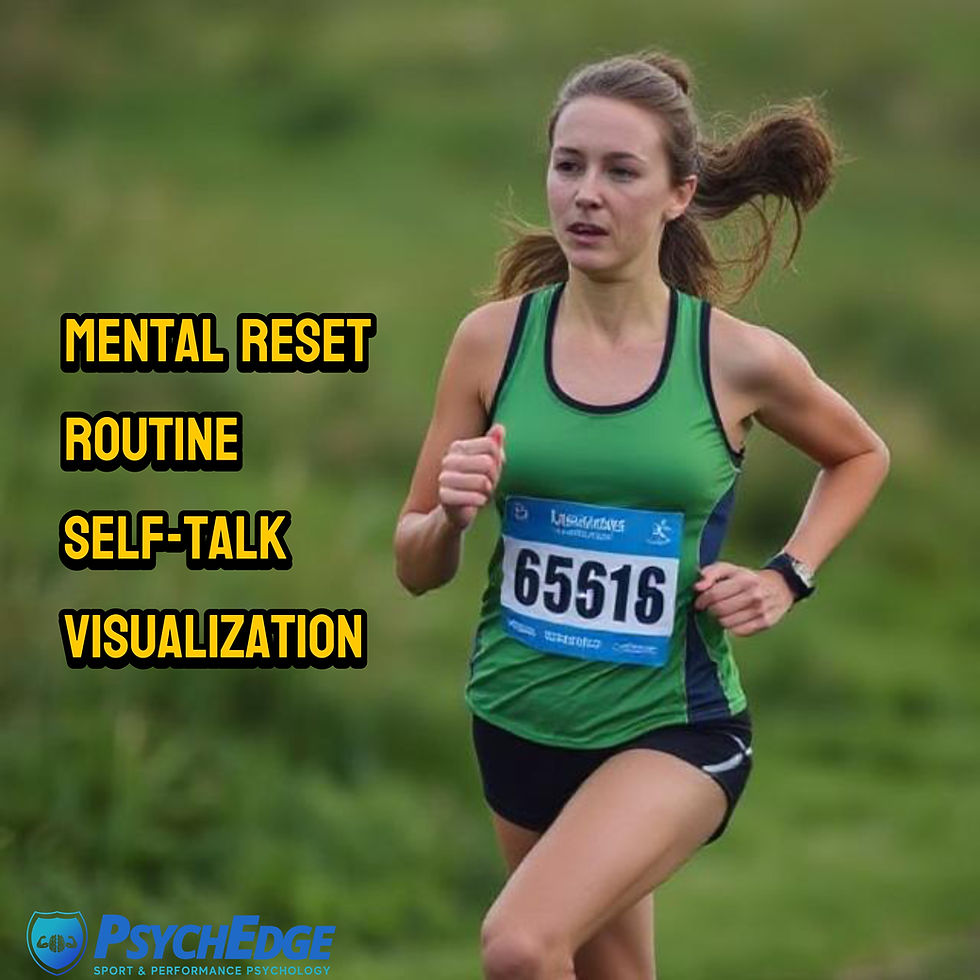Bounce Back Stronger: Resilience and the Growth Mindset in Action
- Sarah Greene- Falk

- Sep 9
- 3 min read
Resilience is the ability to adapt, recover, and grow stronger in the face of challenges. For athletes, students, and high-achieving professionals, resilience isn’t just a nice-to-have—it’s a game-changer. At PsychEdge, we teach mental skills that not only help you handle adversity but also give you the tools to come back stronger, more focused, and more confident.
Why Resilience Matters in Performance
Life and sport are filled with setbacks: a tough loss, an injury, a stressful semester, or self-doubt that sneaks in at the worst times. Resilience is what allows you to respond instead of react—to use challenges as fuel for growth rather than obstacles that derail you.
Think of resilience as your mental muscle. Just like strength training in the gym, resilience grows through consistent practice. Every time you choose to keep going, reframe a setback, or learn from a mistake, you build resilience.
The Growth Mindset Connection
Resilience and growth mindset go hand-in-hand. Seeing loss as an opportunity to learn is growth mindset in action. We want to be careful not to dwell too long or slip into self-loathing—those emotions are real, but they don’t define you.
Instead, give yourself permission to feel the feelings, then flex your control to move forward. That’s where growth and performance happen. This balance is exactly what we train in Module 4 of the PsychEdge Peak Performance Online Course, where athletes and professionals learn emotional regulation and how to transform setbacks into fuel for resilience.
Science of Resilience
Research in sports psychology shows that resilience is linked to greater confidence, stronger emotional regulation, and higher performance under pressure. Athletes who cultivate resilience bounce back faster, maintain focus longer, and manage stress more effectively. Professionals who build resilience handle high-pressure deadlines with more clarity and adaptability.
Neuroscience backs this up: resilience is connected to how flexible and adaptive the brain becomes when managing stress. The more we train resilience, the easier it becomes to reset, recover, and re-engage.
How to Build Resilience Daily
Reframe the Challenge
Instead of asking “Why me?”, ask “What can I learn from this?”. This simple shift changes setbacks into opportunities.
Control the Controllables
Focus on what you can do—your preparation, effort, attitude—not the outcome you can’t control.
Use Visualization
See yourself overcoming obstacles and thriving in high-pressure moments. Visualization rewires your brain to expect success.
Develop Reset Routines
Whether it’s deep breathing, positive self-talk, or a pre-performance ritual, reset tools help you re-center quickly after mistakes or stress.
Practice Gratitude
A daily habit of gratitude trains your mind to look for progress and possibility—even when things feel hard.
Resilience in Action
Michael Jordan famously said: “I’ve failed over and over and over again in my life. And that is why I succeed.” Every missed shot became practice in resilience.
For student-athletes, resilience may mean bouncing back from an injury and staying mentally sharp during recovery. For professionals, it could be handling setbacks at work without losing momentum. Resilience is universal—it applies whether you’re on the field, in the pool, in the office, or at home.
Final Takeaway
Resilience doesn’t mean you won’t feel stress, disappointment, or frustration. It means you choose how to respond. Allow yourself to experience the emotion, then activate your growth mindset to move forward.
Every challenge is an opportunity to grow stronger, more focused, and more prepared for the next step forward. At PsychEdge, we believe resilience is a necessity
of peak performance—and it’s a skill anyone can learn.
#Resilience #GrowthMindset #MentalTraining #SportsPsychology #PsychEdge #PerformanceMindset #BounceBack #MentalToughness #AthleteLife #PeakPerformance


